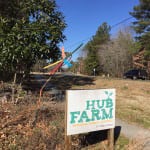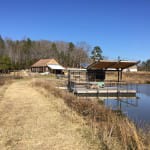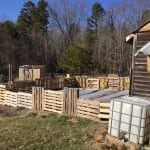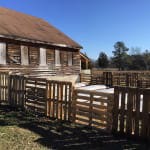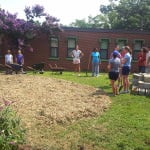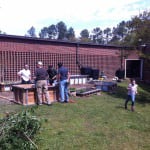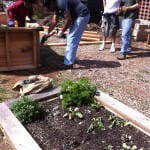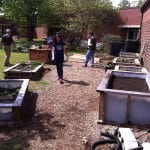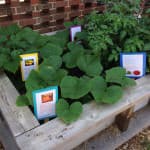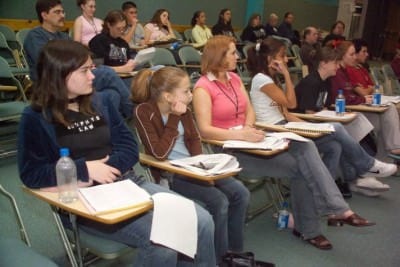Editor’s Note: The 2013 N.C. General Assembly’s Legislative Study Committee on Food Desert Zones found that “School gardens are an important tool for helping students be involved and connected with healthy foods.”
Should every school have a garden?
On a chilly morning in January, I pulled into the parking lot of Warren County High School. I’d driven up to Warrenton from Raleigh for a volunteer workday in a rare kind of place: a GAP certified (Good Agricultural Practice) school garden, initiated by a high school garden club, where collards and cabbage can be grown using state-certified food safety practices and then sold into the Warren County School cafeterias. Partway through the morning, among rich soil and over-wintered cabbages, with my hands full of weeds and my body starting to warm from the activity, I straightened up and took a good look at the people around me in the garden.
While pointing at the 10-foot deer fence, the greenhouse, the various plots, and the school building itself, they talked about how this garden has been pulling people together from its inception.
Across the raised bed was the younger brother of one of the high school garden club members. Next to him was the NC FoodCorps fellow, Caroline Stover, and her Warren County colleague, FoodCorps service member Rachel Head. There were lots of kids, some teachers, community members, and some volunteers that must have been upwards of seventy years old. Really? Nearly 50 people had turned out to weed a school garden on a winter morning?
I stood up and walked over to a group of youth, and soon found myself in the thick of the story I’d hoped to find. These high schoolers were in the garden club at Warren County High School. They explained the hard parts of starting the garden three years ago, and how the experience has changed their attitudes towards food, nutrition, and even towards their hometown. While pointing at the 10-foot deer fence, the greenhouse, the various plots, and the school building itself, they talked about how this garden has been pulling people together from its inception.
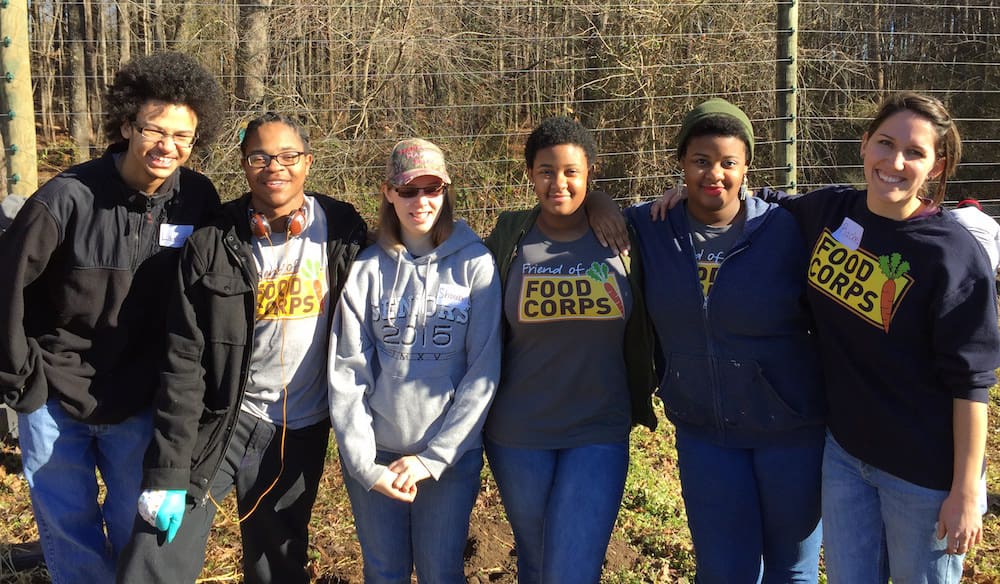
School gardens support strong communities
They said they now saw themselves as part of the future of this rural county, as part of a new food economy and a strong community. They explained how, with the support of FoodCorps and Working Landscapes, a local nonprofit building food system opportunities in the county, they had prepared for and passed an NC Department of Agriculture audit for GAP certification. They explained how their work builds the local economy, provides local food to classmates, delivers fresh produce to teachers, and builds positive perceptions of farming and new connections among youth in their community.
Now I was starting to understand what motivated this diverse crowd to come out on a cold morning.
Should every school have a garden? In every school district?
Rachel Head, the local FoodCorps service member, said it this way: “Today is a perfect illustration of how school gardens can interact positively with a community. Fostering these inter-generational relationships in educational, learning places is great for community enrichment.”
Here’s another thing: Drawing on the support of folks like Head, every school in Warren County except one has a garden. And that last one is being planned.
Warren County Schools are well on their way to 100 percent school gardens, but how important is that? Should every school have a garden? In every school district?
I met a woman named Amanda Lee Brown at the workday who believes the answer is yes. This nursery operator’s ambitious vision includes a garden and greenhouse in every school in Wilson, Wayne, and Nash Counties that connect leadership, technology, and experiential learning with the food and health needs of future generations. “Good food prepares kids for more curiosity, and when kids grow vegetables they’ll want to eat vegetables,” Brown says, echoing the “grow kale, eat kale” philosophy of Ron Finley.
School gardens are educational tools
Where else is this happening? With only a little web research, I learned that the school system in Davis, CA, the home of agricultural research giant UC-Davis, has a farm-to-school program with a garden in every school. It’s easy to find similar programs across the country. Where the message I heard in Warren County emphasized building community, food awareness, and the local economy, the school gardens in Davis “support California’s academic content standards and provide important hands-on learning experiences for students.”
It made sense to me that school gardens had to work on an educational level too. To find out what was going on in Western NC, I called up Emily Jackson, who filled in the blanks.
“When I was a classroom teacher and started a garden,” Jackson told me, “the question wasn’t nutrition or food access, the question was how to motivate kids to learn … You don’t have to talk a kid into working in a garden. They get it.”
“You don’t have to talk a kid into working in a garden. They get it.”
– Emily Jackson
Emily Jackson works for the Appalachian Sustainable Agriculture Project (ASAP) as the Program Director for their 12-year-old Growing Minds Farm to School program. ASAP programs reach 23 counties in Western NC as well as portions of South Carolina, Georgia, Tennessee, and Virginia. Jackson’s Farm to School program includes school gardens, farm field trips, local food in school cafeterias, cooking classes, and even teacher training programs that expose new teachers to the educational opportunities is gardens.
ASAP is clearly bringing a holistic, “all hands on deck” game plan to their Farm to School work. In 2013-14, Jackson’s team worked with 120 schools, with all ages of students. I asked Jackson why school gardens were so important as part of their approach. She talked about community connections, school spirit, food, and health. But what she really emphasized? Gardens are amazing educational tools:
- School gardens are interdisciplinary, allowing any subject to be taught.
- Gardens encourage experiential learning and teaching to all learning styles.
- Gardens allow learning through inquiry.
- Kids get excited about being in a garden, learning to pick and eat fresh food, and will pay attention to lessons if they know they’ll get to pick beans or carrots or kale at the end of them.
- In schools with many languages spoken, gardens help overcome language barriers.
In Durham, the two-year-old Durham Public Schools Hub Farm provides another illustration of the deep educational opportunities around gardening and outdoor learning. Amid a rehabilitated barn, an innovative floating classroom, chickens, and row crops, this project serves 70-300 students per week from kindergarten to 12th grade, using a range of agricultural activities along with extensive woods and three ponds to engage students in a wide educational spectrum.
Katherine Gill, Project Manager and landscape architect at the Hub Farm, says, “Everything we do ties into science, health, nutrition, and physical activity, but we are also able to tie in literacy, math, arts, music. Hands-on, applied learning really allows students to experience a full breadth of learning and engagement.”
Numerous studies confirm the power of garden-based learning that results in increases in science achievement scores, greater health and food knowledge, and improvements in general learning outcomes. Robin Moore, of the NCSU-based Natural Learning Initiative, has written that, “Gardens offer immediate educational potential . . . enabling children to interact with nature, to learn about the ecological cycle. By cooperating with each other, peers achieve almost immediate visible results from their own hard work.”
Numerous studies confirm the power of garden-based learning that results in increases in science achievement scores, greater health and food knowledge, and improvements in general learning outcomes.
The direct educational opportunities that all of these gardens allow, however, is not the end of the story. There is more to a child’s development than formal lessons.
Reverend Willliam Kearney, a consultant and former cop that I met at the Warren County High School garden, sees kids learning patience and overcoming disciplinary challenges by spending time in school gardens. School gardens also foster positive social change. “Working together in gardens builds relationships,” he says, “that overcome assumptions and help bring down walls between us.”
Cris Laurens, a teacher at Raleigh’s Powell Elementary School, shares similar stories related to her work in Powell’s garden. When given the chance to spend afterschool hours in the school garden only if they could stay free of disciplinary problems, she has seen students become more self-aware of actions, working hard to control behavior, and being rewarded, strangely enough, with afterschool garden work.
Starting school gardens: It has to work for the teachers
In her twelve years with ASAP’s Growing Minds, and with her experience as a classroom teacher, what does Emily Jackson think about getting school gardens going?
She starts by saying that the teachers’ ability to make things happen is critical for success. We all know, she says, “That teachers are overburdened and asked to do too many things.”
She goes on to tell me something that seems hard to square with teachers’ workloads.
“Teachers are most often the garden champions, the do-ers who can make it happen. Mostly teachers get gardens going.” Teachers, already overworked, are nevertheless the ones we need to look to if school gardens are going to be successful.
Michele McKinley of Wake County’s Advocates for Health in Action (AHA) sees both sides of this situation as well. AHA has been involved in school garden promotion for over six years in Wake County. McKinley stresses the need for teachers to see a garden as a learning tool and overall benefit to their day, instead of avoiding garden use “because they are feeling like it’s ‘one more thing to do.'”
Allow flexibility. Start small. Learn and expand as you go.
To make school gardens and garden-based teaching possible for our overworked teachers, Jackson says that we have to make it easy for teachers to be involved. Don’t start with a set garden curriculum; allow teachers to integrate the garden setting into what they are already doing. Allow flexibility. Start small. Learn and expand as you go.
Jackson says that starting a garden involves upfront work that can’t be avoided. Creativity and community resources can help overcome this barrier.
In a Raleigh example of garden building, a landscape contracting firm called Greenscape partnered with the landscape design practice Naked Fruits, and collaborated with students and an outdoor living group called Come Alive Outside to help Root Elementary develop its garden. According to AHA’s Michele McKinley, this unique collaboration provided, “service for the Greenscape folks, applied learning opportunities for the NSCU students, and school students and staff benefiting from a garden –a learning tool—they can use for a long time.”
In another Raleigh example, my own firm, Community Food Lab, designed a school garden at Powell Elementary School that was built in a series of ‘garden mob’ work days that brought together students, parents, teachers, and community organizations to get the whole garden built over two years. These events allowed a lot of work in a short time, built a shared sense of accomplishment, and fostered lasting connections.
Studies confirm the stories. Students’ life skills, social skills, behaviors, and self-understanding all improve with time spent in school gardens.
This kind of collective garden building is a first step into what Jackson sees as another hidden benefit of gardens: they can help parents feel comfortable at school.
“Schools can be scary, uncomfortable places for some parents. Gardens are terrific ways for some parents to begin engaging at school,” Jackson says.
School gardens, GAP, and food access
“We know that children are not getting the recommended amount of fruits and vegetables daily,” says McKinley, “School gardens can be a really important strategy to change that.”
How can a raised bed outside a second grade classroom, or a GAP certified cabbage plot change the fruit and vegetable intake of our school kids?
Well, there are two main ways that change happens.
First, kids take what they learn in a garden home with them.
“As kids learn more about food they seek that same quality and experience of food when they get home.”
– Tim Williams
Tim Williams with Warren County’s Working Landscapes sees kids of all ages disconnected from food. School gardens, he says, are ways to get them engaged with food. “As kids learn more about food they seek that same quality and experience of food when they get home,” he says.
Emily Jackson agrees, and sees intergenerational excitement happening as well. “Lessons in the gardens can go home with students. Kids get excited and can get their families involved in gardening. Often, you get grandparents involved, too,” she says.
Jackson’s work at ASAP also includes some hard data.
ASAP has been collecting surveys that ask parents how often their children come home from school and mention what they did in the school garden. Their study isn’t complete yet, but Jackson says that the patterns they are finding in school-to-home garden sharing are “fabulous.” When kids spend time in a school garden it is one of their favorite things to tell their parents about.
School garden food can reach people through food donations, direct sales to consumers, or when GAP-certified gardens can sell right into the school cafeteria.
Second, change in local food access happens when school gardens get their produce to folks that need it. School garden food can reach people through food donations, direct sales to consumers, or when GAP-certified gardens can sell right into the school cafeteria.
Michele McKinley notes that, “Some school gardens donate their produce (all or some) to programs like Plant a Row for the Hungry, so school gardens are contributing to healthy food access to at-risk populations that need healthier choices.”
The DPS Hub Farm also distributes food in various ways. In addition to an on-site farmstand and occasional sales at the Durham County Health Department, “we sell some produce to local restaurants,” Katherine Gill says, “and are also starting to work more directly with DPS Nutritional Services to do taste tests and family dinners at school cafeterias.”
Gill points out that the Hub Farm’s work with DPS Nutritional Services doesn’t, at this time, include selling produce to be served in school cafeterias, because they aren’t yet GAP-certified.
A natural opportunity for garden-to-table learning comes when school gardens sell directly into schools, but this isn’t an option for the vast majority of NC school gardens. NC schools can only serve GAP-certified produce, grown in state inspected farms and gardens.
School systems … use growers that are GAP certified as a way to ensure the safety of the food they purchase and serve.
There are currently only two GAP school gardens in NC that are certified to sell into school cafeterias. GAP stands for Good Agricultural Practice, and the two GAP certified school gardens are located in Stokes County and Warren County. Remember how I said the Warren County High School garden was rare?
The GAP certification process is administered by the NC Department of Agriculture, and it involves a periodic audit of the growing, harvesting, and food handling processes for a particular crop. In Warren County, the high school garden club chose to obtain GAP certification for collard greens and cabbage, so these two products are what they can sell to the school.
School systems (and many other large buyers) use growers that are GAP certified as a way to ensure the safety of the food they purchase and serve. School cafeteria GAP requirements are consistent across NC, meaning that food grown in a non-certified school garden cannot make its way into the cafeteria.
For schools interested in growing GAP-certified produce, it is important to weigh the costs and benefits of becoming certified. Warren and Stokes counties have schools gardens that have achieved certification, and the DPS Hub Farm is planning to become GAP certified. The process is not without expense, however.
To start, GAP certification has costs associated with the audit and travel for the inspector, though the state offers some cost-sharing opportunities. Other, maybe unexpected, costs are associated with equipment and infrastructure, like fences or hand washes that the GAP standards require. Also important to consider is the training needed to make sure that every person growing or harvesting certified food is up to speed on the procedures. At Warren County High School, the whole garden club spent hours learning all the ins and outs before the state inspector came to audit them, so that their harvesting process was precisely performed.
Community building, educational opportunities, food access, and the health of students and families all come through the school gardens.
As more small farms and school gardens become GAP-certified, more school systems will be able to include diverse local produce in their nutrition programs.
In the meantime, teachers and students can still reap the amazing rewards that school gardens deliver. Community building, educational opportunities, food access, and the health of students and families all come through the school gardens.
“School gardens are the best overlap of bringing health and education together,” Emily Jackson says, “which so rarely happens. But it’s a natural fit. You don’t have to talk a kid into working in a garden. Kids get food.”
And as a teacher? Jackson recalls her days as a classroom teacher.
“The garden was my favorite because of its constancy through all the seasons. On nice days, I could just lay a blanket down and have reading time with my class in the garden.”


